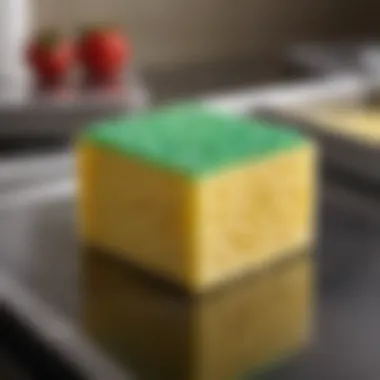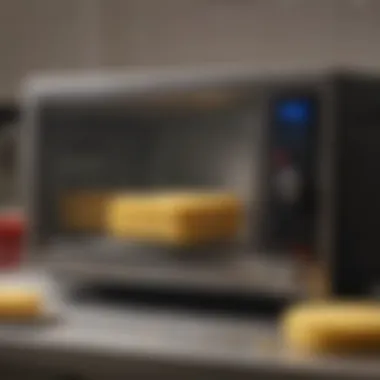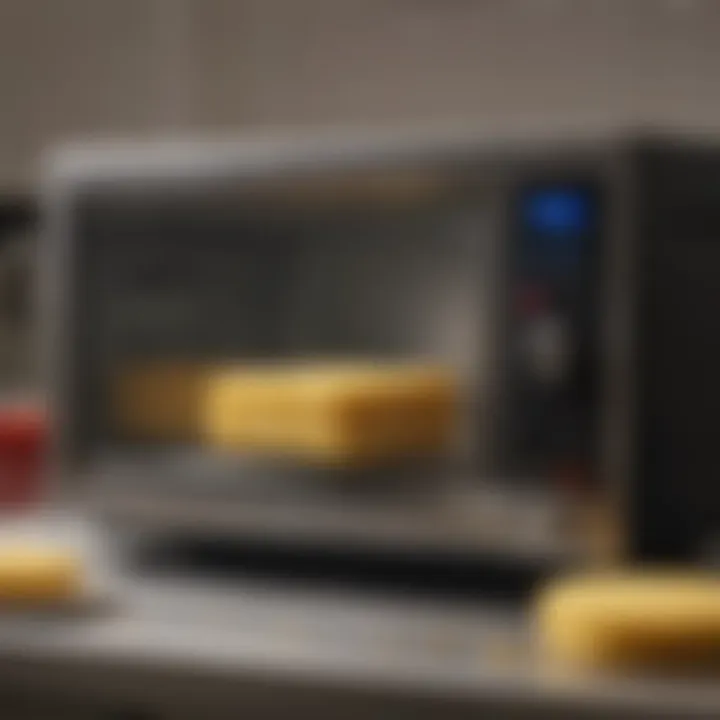Microwave Sponge Sterilization: A Simple How-To Guide


Intro
Maintaining hygiene in the kitchen is crucial. One of the primary breeding grounds for bacteria is the kitchen sponge. Thus, it becomes imperative to address this issue. The microwave offers a rapid solution for sanitizing sponges effectively. This method not only reduces microbial populations but also helps prolong the lifespan of your sponges.
In this guide, we shall explore the science backing sponge contamination and why regular sterilization is important. We present easy microwave techniques aimed at busy professionals and families alike. With straightforward instructions, you will learn how to keep your kitchen sponges sanitized without monopolizing your time.
Key Points to be Discussed
- Understanding kitchen sponge contamination and its perils
- Significance of regular sponge sterilization
- Step-by-step approach to microwave sterilization
- Additional tips for sponge care and maintenance
Making the task more manageable, let us delve into how you can effectively sanitize a sponge in the microwave setting the stage for a cleaner kitchen environment.
Understanding the Need for Sponge Sterilization
Sponge usage in the kitchen is commonplace. They function as essential tools for cleaning dishes, wiping surfaces, and soaking up spills. However, due to their constant exposure to food residues and moisture, sponges become a breeding ground for harmful bacteria. Understanding the need for sponge sterilization is crucial for kitchen hygiene. Regular sterilization helps in reducing any risks posed by hidden contaminants. This guidance aims to explore the significance and benefits of thorough sponge care.
The Role of Sponges in the Kitchen
In any home, sponges carry out indispensable roles. They simplify the tedious task of cleaning kitchenware. Without efficient sponges, stubborn stains on pots and pans would pose an ongoing challenge. Clean sponges also contribute to maintaining cleanliness across all surfaces, including countertops, stovetops, and even cutlery. Hence, it is essential to ensure these tools are sanitized regularly, providing not only utility but also comfort in knowing that harmful germs are kept at bay.
Common Contaminants Found in Sponges
The contaminants residing in a raw sponge can vary widely. Microbial growth frequently includes common bacteria such as E. coli, Salmonella, and various strains of Staphylococcus. These microorganisms find suitable conditions in a sponge due to moisture and organic residues. Every time we use a sponge, it absorbs substantial food particles and moisture, creating an ideal environment for dangerous pathogens. This makes understanding what lurks within these everyday items a imperative step toward improved kitchen safety.
Health Risks Associated with Untreated Sponges
Failure to sterilize kitchen sponges can lead to serious health complications. When pathogenic bacteria multiply in sponges, cross-contamination occurs easily. This means that washing utensils or surfaces with these soiled sponges can speedily spread microbes. Some potential repercussions include gastrointestinal illnesses and food poisoning, which might manifest subtlety or aggressively. The detrimental health risks are stark reminders of the importance of implementing effective sterilization routines for sponges in any kitchen environment.
Microwave Sterilization: A Brief Overview
Microwave sterilization has gained prominence in modern kitchens as an effective method to disinfect everyday items. This section will delve into the principles behind microwave sterilization, the efficiency of its antibacterial properties, and why it should be a key consideration for anyone looking to maintain kitchen hygiene.
How Microwaves Kill Bacteria
Microwave ovens operate by emitting electromagnetic waves which agitate water molecules within food, sponges, or any objects placed inside. This agitation generates heat, effectively raising the temperature of the items in the microwave. Most bacteria, viruses, and other pathogens cannot withstand high temperatures. Generally, exposed to temperatures above 165°F (73.9°C) for even a few seconds can lead to significant reductions or kills entire populations of these microorganisms.
The reason this method is so effective lies in its uniform heat distribution. Rather than relying on immersion in soap and water, sufficiently heating a damp sponge in a microwave not only successfully heats the outer layers but can reach and treat the inner materials effectively.


Using microwaves is a fast and convenient way to yield similar results to traditional boiling methods without consuming excess water or requiring long wait times. In many busy households, this method significantly enhances maintenance efficiency while tackling bacteria proliferation.
Advantages of Microwave Sterilization
Using a microwave for sponge sterilization offers proceeding benefits that can greatly influence hygiene practices in kitchens:
- Speed: One of the compelling advantages is reduced time. Microwave sterilization commonly requires only a couple of minutes, making this method particularly suited to busiest schedules.
- Convenience: There are no complex procedures or materials involved. The inevitable ease of placing a damp sponge in the microwave makes it an uncomplicated process.
- Energy Efficient: Compared to boiling water on a stove, microwaves consume less energy, making them a practical option for daily household tasks.
- Multi-purpose: Apart from sponges, many other items do well to undergo a similar treatment. Noxious dishes, for instance, can also benefit, ultimately encouraging an all-around approach to cleanliness without extra effort.
- Reduction of Odors: Regular microwave sterilization can also alleviate unpleasant smells. Bacteria buildup typically correlates with foul smells, and eliminating the source helps maintain an inviting environment.
Understand that while microwave sterilization presents notable advantages, certain kinds of sponges, especially those enriched with metal or certain materials, may not be appropriate. Reading instructions specific to your sponges ensures safe and efficient experimentation.
The rapid rise of microwave sterilization has shifted paradigm trends for hygiene solutions many find shocking—an unprecedented number of germs eliminated in a fraction of time!
As we proceed to the next section, deeper insights into preparation steps will further guide you through transforming further your approach to maintaining sponge hygiene effortlessly.
Preparation Steps Before Sterilizing
Preparation plays a crucial role in effectively sterilizing kitchen sponges. Skipping initial preparation may lead to inadequate results. It is important to understand what types of sponges work best for microwave sterilization and how these sponges should be cleaned before the final sterilization. Proper preparation can enhance the effectiveness of the sterilization process and ensure a hygienic kitchen environment.
Identifying Suitable Sponges
Not all sponges are created equal. Some sponges are specifically designed for heavy-duty cleaning while others are more for light tasks. When choosing sponges to sterilize in the microwave, ensure that they are microwave-safe. Most common types like cellulose or polyester sponges are effective candidates.
- Avoid sponges with metal scouring pads, as they can cause sparks or even fires during the process.
- Additionally, always check for clear indicators on the sponge packaging regarding their microwave safety. Studying the product's labels can provide insight not only on materials used but also if they can handle microwave heat.
Cleaning the Sponge: Initial Rinse
The initial rinse is an important step before microwaving your sponge. This step diminishes the load of contaminants and dirt on the surface, helping the microwaving process to focus on sterilizing bacteria. Failing to rinse your sponge can also release unwanted smells and chemicals into your microwave space.
Start by rinsing the sponge under hot water. Ensure you squeeze out as much dirt and residue as possible. This step also prepares the sponge to retain moisture needed in microwave sterilization. Overall, keeping the sponge wet promotes effective steam generation, which is essential for killing bacteria effectively.
By performing these preparatory steps, you set the stage for successful sponge sterilization, emphasizing cleanliness in day-to-day kitchen practices.
Key Points: Choose suitable sponges and perform an initial rinse to enhance the sanitation process. This preparation is significantly essential for effective results in the following sterilization steps.
Step-by-Step Guide to Microwave Sterilization
To maintain a clean kitchen, emphasizing the importance of sponge sterilization is crucial. Sponges collect bacteria, food particles, and grime daily. Therefore, microwaving sponges is an effective way to destroy harmful microorganisms without requiring harsh chemicals. By following a clear, structured approach, you can ensure that your sponges remain free from contaminants, which is vital for overall kitchen hygiene.
Ideal Microwave Settings


Choosing the correct settings for your microwave is fundamental to successful sterilization. Most microwaves come with default settings that are suitable for reheating and cooking food. However, for sponge sterilization, high power should generally be used. This ensures the maximum heat reaches the sponge quickly.
- Set the microwave to high power.
- Ensure that the microwave is clean to prevent cross-contamination.
The settings can vary slightly depending on the microwave brand and model. A strong power level will aid in delivering the heat needed to exterminate the bacteria effectively.
Timing the Sterilization Process
Timing plays an essential role in the sterilization process. Each microwave might have different wattages, which affect how long the sponge should be heated. Typically, 1 minute is sufficient for most sponges. It is insightful to monitor the sponge closely during this time.
- Start with 1 minute and adjust as necessary.
- If the sponge is particularly dirty or hasn't been cleaned in a while, extending the time to 1.5 minutes may be required.
- As microwaves operate differently, pay attention to the sponge. If it feels overly hot, it could be a signal to reduce heat exposure next time.
Positioning the Sponge in the Microwave
Correctly positioning the sponge inside the microwave is critical for even heating. Place the sponge flat in the center of the turntable for uniform distribution of microwaves. Sponges often absorb moisture; thus, adding a cup of water in the microwave can create steam, enhancing the heating process.
- Lay the sponge flat and center in the microwave.
- Place a microwave-safe cup filled with water beside the sponge to generate steam custody.
Proper positioning guarantees that heat is effectively transmitted to all areas of the sponge, ensuring that it parts with lingering pathogens.
Early and routine sterilization of kitchen sponges cuts down the risk of foodborne illness and maintains a sanitary cooking environment.
By understanding these essential steps, you ensure that the practice of sponge sterilization becomes a routine part of your kitchen care. Use these guidelines to make informed decisions that foster the hygiene of your kitchen and the safety of your food preparation.
Post-Sterilization: Ensuring Safety
Ensuring safety after the sponge sterilization process is crucial in maintaining hygiene in your kitchen. Once you remove the sponge from the microwave, it is essential to follow specific steps to minimize risks associated with damage and warrant effective use. Understanding this process prevents increased risks of cross-contamination or ineffective cleaning.
Allowing the Sponge to Cool
After the microwave cycle is complete, the sponge will be extremely hot. Allowing the sponge to cool is a necessary part of the post-sterilization process. If you do not wait, you might burn yourself, as the materials' exterior will feel much cooler than the interior very quickly. Ignoring this step could lead to severe burns or accidents. Make sure you handle the sponge with caution, using protective mitts if necessary.
A general rule is to let the sponge cool for about 15 minutes before handling it directly. This waiting time enables the heat to dissipate and ensures that the sponge is safe to use afterward. This step also preserves the integrity of the materials used to manufacture the sponge, allowing it to maintain its texture and cleaning ability over time.
Identifying Signs of Damage
Once the sponge has cooled, it is imperative you carefully examine it for any signs of damage. Sterilization in the microwave can sometimes degrade the material. Look for any discoloration, fraying, or melting. If you notice these changes, you should consider replacing the sponge immediately. Using a damaged sponge can not only be ineffective at cleaning surfaces but also pose health risks due to the deterioration of materials. Non-native English speakers may find it easier to express these signs using simple words. Damage affects how shade and texture; visualize wool losing soft or becoming rough.
Regular inspection helps maintain proper hygiene, prolong the sponge's life and ensure excerising safe practices in your kitchen. Discarding a damaged sponge is a simple step that makes a big difference in maintaining a clean and safe cooking environment.


Always be vigilant in inspecting a sponge after hahits each process of using in a microwave and remember: an ineffective cleaning tool can attract unwanted bacteria rather than ward them off.
Maintaining Sponge Hygiene
Maintaining sponge hygiene is essential for kitchen cleanliness and health. Sponges, though handy, can harbor bacteria which pose health risks. Understanding how often to sterilize sponges, exploring alternative cleaning methods, and effectively storing them can significantly reduce risks.
Frequency of Sterilization
It's important to sterilize sponges regularly. A good rule is to do so at least once a week. However, the frequency may depend on usage. For those who frequently cook raw food or deal with spills, sterilizing every few days is beneficial. Not only does this enhance hygiene, but it prolongs the life of your sponge.
Frequent sterilization prevents the buildup of bacteria that occurs from food residues and moisture. Consistency in this practice promotes a healthier kitchen environment. Additionally, remember to wash sponges in the dishwasher occasionally. This also supports their longevity.
Alternative Cleaning Methods
While microwave sterilization is effective, there are other cleaning methods worth considering. Here are a few:
- Boiling: Place sponges in boiling water for a few minutes. This can effectively kill off bacteria.
- Vinegar Soak: Soaking sponges in a vinegar solution for about five minutes is natural and helps deodorize while disinfecting.
- Bleach Solution: For a stronger option, dilute bleach in water and soak sponges for several minutes. Always rinse thoroughly.
These options not only offer variety but also ensure that sponges are consistently clean and safe to use in the kitchen.
Best Practices for Sponge Storage
Proper storage of sponges can enhance their hygiene. Here are tips to consider:
- Dry Between Uses: After each use, wring out excess moisture and place the sponge in a well-ventilated area. Making sure they dry completely helps prevent bacterial growth.
- Use a Dedicated Holder: Invest in a holder that allows for drainage. Avoid storing sponges in closed containers where moisture can accumulate.
- Limit Use for Specific Tasks: Having separate sponges for dishes and wiping surfaces can help minimize cross-contamination.
By integrating these storage practices, kitchens can maintain a cleaner, safer environment for food preparation.
Maintaining proper hygiene standards for sponges is often overlooked yet crucial for health and safety in the kitchen. The cumulative effects are widely significant, especially for those preparing meals frequently.
Ending: The Importance of Regular Sponge Care
Maintaining the cleanliness of kitchen sponges is essential. Clean sponges contribute significantly to overall kitchen hygiene. Regular sterilization helps in reducing the risk of foodborne illness caused by bacteria lurking in these everyday items. This part of your cleaning routine cannot be overlooked.
When sponges are not regularly cleaned, they can harbor bacteria such as E. coli and salmonella. These bacteria can spread to your dishes and countertops, posing a health risk to everyone in the household.
Frequency of Sponge Care plays an integral role in food safety. Implementing a regular sterilization schedule not only improves hygiene but also prolongs the life of the sponge. Most professionals advise sterilizing sponges at least once every week, or even more often in households where heavy cooking takes place.
Regular sponge care is not just beneficial—it's necessary for a healthy kitchen environment.
Understanding the benefits of sterilization significantly helps in adopting and maintaining this practice. Proper sterilization methods can kill up to 99% of bacteria in sponges. Utilizing the microwave method can save time while ensuring effective sanitation.
This leads to better kitchen safety for you and your family. Safety measures, such as checking the condition of the sponge after each cleaning session, are crucial. A damaged sponge might offer a breeding ground for germs despite your best efforts.
In summary, consistent sponge care circles back to a fundamental principle in hygiene. It exemplifies how a minor aspect of kitchen cleanliness significantly impacts the broader goal of maintaining sanitary cooking spaces. Adopting these few simple steps makes a noteable difference in safeguarding health and prolonging properties of kitchen sponges, helping you provide a safe environment for meal preparation while easing your cleaning routine.







